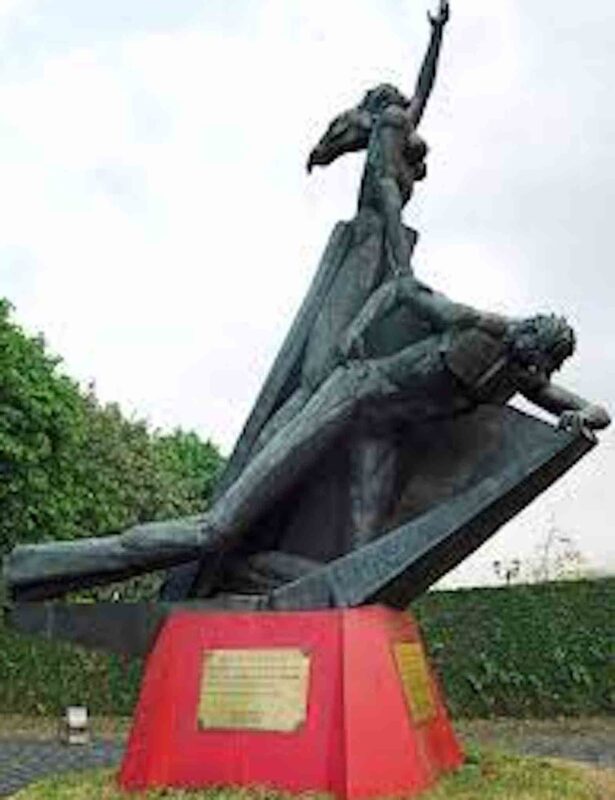
Visible from the avenue even before one proceeds to the entrance of the Bantayog ng Mga Bayani is Ed Castrillo’s 14-meter-high monumental sculpture Inang Bayan or Motherland.
QUEZON CITY—I paid a visit to the Bantayog ng Mga Bayani (Memorial of Heroes), one I had been meaning to for quite a while, given longer pause of four years due to the pandemic. The Bantayog’s sprawling grounds on Quezon Avenue are right near the corner of the capital region’s main ring road, EDSA. Visible from the avenue even before one proceeds to the entrance is Ed Castrillo’s 14-meter-high monumental sculpture Inang Bayan or Motherland.
With his trademark stylized El Greco-like figures, the mother has one arm reaching for the sky, and the other holding up the male figure, hero and martyr, from completely falling down. At the base is an excerpt from Jose Rizal’s Mi Ultimo Adios (My Last Farewell), “I die just when I see the dawn break/ Through the gloom of night, to herald the day:/And if color is lacking my blood thou shall take,/ Pour’d out at need for thy dear sake,/ To dye with its crimson the waking ray,” rendered as well in Tagalog and the original Spanish. =
Echoing and amplifying the mother’s gesture—or perhaps it is the other way around—are several bodhi trees that line the path to Inang Bayan. The bodhi tree is of course the tree under which the Buddha sat and achieved enlightenment. These trees are both frightening and exhilarating—dark and massive, spectral, in a way as fantastical as the trees in Tolkien’s epic Lord of the Rings. These are trees that remember, that cry to the heavens for redress.
With its uncompromising stance, and designed by Ildefonso Santos, Jr., proclaimed National Artist for Landscape Architecture in 2006, the Bantayog ng mga Bayani is meant to honor all who resisted the injustices of the Marcos dictatorship, insistent on their rights as citizens and human beings. Consisting of a Wall of Remembrance, a museum, and the Castrillo sculpture, the memorial honors not only the martyrs killed by the martial regime of Ferdinand and Imelda Marcos but also those who stood up to it, coming from all walks of life and different ideological perspectives without being salvaged—the term used in that era, the equivalent of desaparecidos—and who thus passed away peacefully. Names are added each year, as deceased individuals are nominated by their families, civic organizations, the public, vetted to verify the stories and whether indeed these do qualify the nominees for inclusion.
First inscribed on the granite wall in 1992, many of the names are well-known, among them Senators Benigno “Ninoy” Aquino—assassinated on the airport tarmac on August 21, 1983—Lorenzo Tanada, and Jose Diokno; provincial governor Evelio Javier; Bishop Antonio Fortich; Sister Christine Tan; poet-turned-warrior Emmanuel Lacaba; activists Lean Alejandro, Edgar Jopson, Rizalina Ilagan, and Liliosa Hilao; Kalinga tribal elder Macling Dulag; and publisher Jose Burgos, Jr. The wall reminded me of Maya Lin’s Vietnam Wall in Washington, DC, where the names are similarly inscribed on the wall, though there the wall material is reflective: in contemplating the names one can also see his or her reflection.
The Bantayog has also assembled an archive of documents relating to that unlamented era, donated by various donors: families, civic groups, schools, etc.—an archive that is the only one of its kind in the country and perhaps the world. Given how history is being repeated—alas, we as a nation seem to make a virtue out of historical amnesia—with the namesake son of the late Ferdinand Marcos now president and hailing the martial-law era as a “golden age,” the Bantayog is needed now more than ever as the necessary counternarrative to the continuing disinformation campaign, bankrolled by the Marcoses’ vast illicit wealth, glossing over those dark days.
You may like: More stories of sacrifice, defiance echo at Bantayog
Unfortunately, the building, named after the late Senator Jovito Salonga, is in dire need of repairs, the monsoon rains having inflicted serious water damage. The exhibitions, presented in chronological order, have so far been spared, but the showcasing leaves a lot to be desired. These present a wealth of information on the circumstances of the citizenry’s lives under the yoke of the dictatorship. One of the more compelling exhibits is a faithful reproduction of a prison cell, cramped, dimly lit, claustrophobia-inducing. Another details graphically the various modes of torture to get detainees to confess.
Other exhibits include a comprehensive diagram of different organizations involved in resisting the Marcos dictatorship ranging from the conservative Makati Business Club, to the progressive labor group Kilusang Mayo Uno, or May First Movement. Beside the museum’s main gallery is the “Hall or Remembrance,” that provides capsule biographies of the heroes and martyrs, coming from various sectors, honored outside, on the Wall of Remembrance.
While it does get some funding, noticeably from the Quezon City municipal government, enough to keep the lights on and provide minimal upkeep, the Bantayog would clearly benefit from some angel making a hefty donation. It would be a truly sad commentary on the way the nation treats its recent past were the Bantayog allowed to go ungently into that good night.
Copyright L.H. Francia 2023

